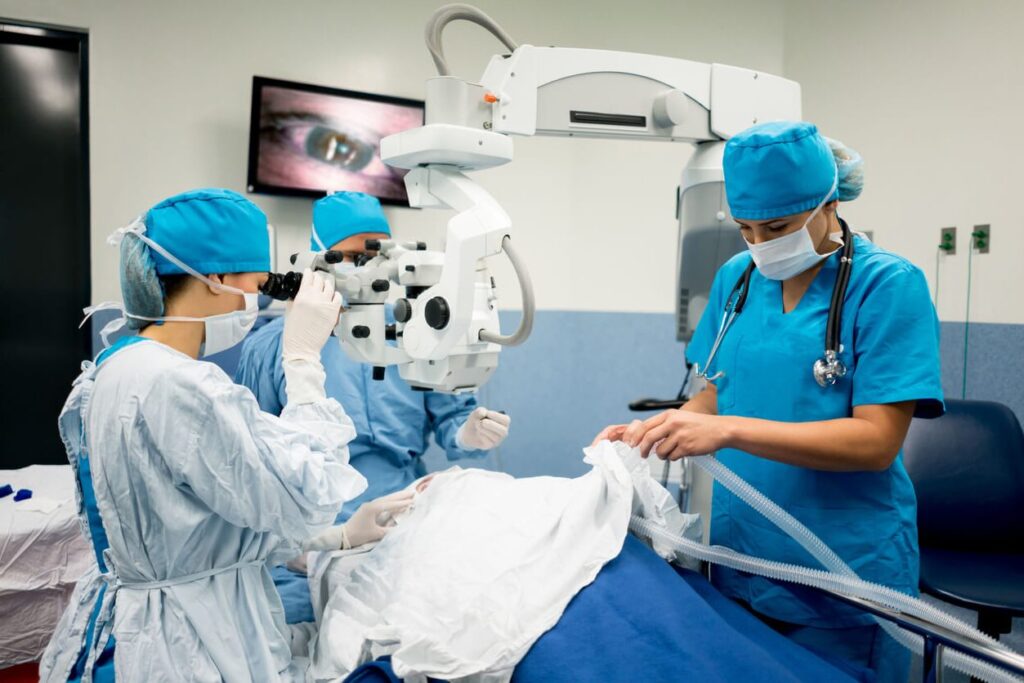Cataract surgery is a common procedure aimed at restoring vision by replacing the cloudy lens of the eye with a clear artificial lens. While most patients experience significant improvement in their vision post-surgery, the recovery process is crucial for ensuring long-term success and comfort. This article provides comprehensive recovery tips to help individuals navigate their post-operative journey effectively.
Understanding Cataract Surgery
What is Cataract Surgery?
Cataract surgery is a surgical procedure performed to remove the natural lens of the eye that has become cloudy, a condition known as cataract. During the procedure, a small incision is made in the eye, and the cloudy lens is broken up and removed using ultrasound technology. Subsequently, an artificial intraocular lens (IOL) is implanted to restore clarity to the vision.
In conclusion, recovery after cataract surgery Sydney is a critical process that requires attention and care. By understanding the procedure, preparing adequately, and following through with aftercare guidelines, patients can optimize their recovery, ensuring enhanced vision and quality of life. It is important to remember that every individual’s recovery journey is unique, and maintaining open communication with healthcare providers will yield the best outcomes.
The surgery is usually performed on an outpatient basis, meaning individuals can go home the same day. Although it is considered a safe and effective procedure, understanding what happens during the surgery can alleviate concerns and help set realistic expectations for recovery. Many patients experience significant improvements in their vision shortly after the procedure, often describing colors as more vibrant and details as sharper. This immediate enhancement can be a profound relief for those who have struggled with the gradual decline in their eyesight due to cataracts.
The Importance of Post-Surgery Care
Post-surgery care is vital for ensuring optimal recovery and the best possible outcomes. Proper care can prevent complications such as infections, excessive swelling, or even vision loss. Following the surgeon’s specific guidance is crucial, as they will provide tailored instructions based on individual health conditions and surgical details. Common recommendations include using prescribed eye drops to reduce inflammation and prevent infection, as well as wearing protective eyewear to shield the eye from dust and debris during the healing process.
Patients who adhere to their aftercare regimen often report faster and more comfortable recoveries, as well as improved overall satisfaction with the surgical results. Hence, understanding and committing to the necessary steps for post-surgery care cannot be overstated. Regular follow-up appointments are also essential, as they allow the surgeon to monitor the healing process and address any concerns that may arise. Additionally, engaging in gentle activities and avoiding strenuous exercise can further support a smooth recovery, allowing patients to gradually return to their normal routines while safeguarding their newly restored vision.

Preparing for Post-Surgery Recovery
Setting Up Your Recovery Space
Preparation is essential before undergoing cataract surgery. Creating a comfortable recovery space in your home can significantly enhance your experience. Consider a quiet area where you can rest without distractions, and ensure that essential items such as medications, eye drops, and water are easily accessible.
Additionally, it may be helpful to have good lighting available for reading or performing light activities during your recovery. You should also arrange seating or sleeping areas to minimize movements that could strain your eyes, especially during the first few days post-surgery. Soft pillows and blankets can make your space more inviting, while a nearby table can hold your essentials within arm’s reach, reducing the need to get up frequently.
Furthermore, consider incorporating calming elements into your recovery space, such as soothing music or gentle aromatherapy. These can help create a peaceful atmosphere conducive to healing. Keeping your environment tidy and organized can also alleviate stress, allowing you to focus solely on your recovery without the distraction of clutter.
Arranging for Assistance
Post-surgery recovery may limit your ability to perform daily activities independently. It is advisable to arrange for assistance from family members or friends during the initial recovery period. They can help with tasks such as cooking, cleaning, and running errands, allowing you to focus on healing.
Moreover, having someone available can provide emotional support, addressing any concerns or discomfort you may experience as you adjust to your improved vision. This support network plays an important role in your overall recovery and peace of mind. It can also be beneficial to establish a schedule with your helpers, ensuring that you have consistent support throughout the day, particularly during times when you may need to take medications or perform eye care routines.
In addition to friends and family, consider reaching out to local community services or support groups that may offer assistance for individuals recovering from surgery. These resources can provide additional help, whether through meal delivery services or companionship, allowing you to feel more secure and cared for during this transitional period. Engaging with others who have undergone similar experiences can also provide valuable insights and encouragement as you navigate your recovery journey. Read more about resources on https://www.sciencedirect.com/topics/social-sciences/educational-resource
Immediate Aftercare for Cataract Surgery
First 24 Hours Post-Surgery
The first 24 hours after cataract surgery are critical. Patients may experience some mild discomfort, but this should not be excessive. To facilitate recovery, it is recommended to rest your eyes and avoid strenuous activities during this period. Keeping your head elevated while resting may also help reduce swelling. It is advisable to limit screen time, as the blue light emitted from devices can cause strain and discomfort. Instead, consider engaging in light activities that do not require visual concentration, such as listening to audiobooks or music, which can provide a soothing distraction.

During this time, it is essential to follow your surgeon’s directions regarding eye protection and medications. You may be instructed to wear an eye shield while sleeping to protect the eye and prevent accidental rubbing or pressure. Additionally, creating a calm environment can further aid in recovery; dimming the lights and minimizing noise can help your eyes relax and heal more effectively. Family members or caregivers can assist by ensuring that you have everything you need within reach, reducing the need to strain or move around unnecessarily.
Medications and Eye Drops
Medications prescribed by your surgeon are crucial for proper recovery. Typically, these include antibiotics to prevent infection and anti-inflammatory eye drops to reduce swelling and discomfort. Be diligent about adhering to the prescribed schedule for administering these medications, as they play a key role in the healing process. Keeping a medication log or setting reminders on your phone can help ensure that you do not miss a dose. It’s also beneficial to have a designated area for your medications to keep them organized and easily accessible.
It is also important to avoid using any itch-relieving or redness-reducing eye drops unless specifically approved by your surgeon. Using non-prescribed products could inadvertently impede your recovery. In addition, be cautious about touching your eyes or the surrounding area, as this can introduce bacteria and increase the risk of infection. If you notice any unusual symptoms, such as increased redness, swelling, or changes in vision, do not hesitate to contact your healthcare provider for guidance. Keeping an open line of communication with your medical team is essential for a smooth recovery process.
Long-Term Recovery Strategies
Protecting Your Eyes
Even after the initial recovery phase, protecting your eyes remains important. Avoid exposure to bright lights and UV rays by wearing sunglasses outdoors. Additionally, refrain from swimming or using hot tubs for a few weeks, as these environments can expose your eyes to harmful bacteria. It’s also advisable to limit screen time, as prolonged exposure to screens can lead to eye strain and discomfort, especially during the early stages of recovery when your eyes are still adjusting. Click here to find more about bacteria.
In the months following surgery, be cautious with activities that could cause impact to the face or eyes, such as contact sports. Maintaining a protective attitude towards your eyes will contribute to their overall health and enhance the long-term success of your surgery. Consider incorporating protective eyewear into your routine, especially during activities that pose a risk to your eyes, such as yard work or home improvement projects. Furthermore, a balanced diet rich in vitamins A, C, and E, along with omega-3 fatty acids, can support eye health and promote healing.
Follow-Up Appointments and Check-ups
Regular follow-up appointments with your eye surgeon are essential to monitor your recovery and ensure that your vision is improving correctly. Typically, these check-ups occur within the first week after surgery, followed by several additional visits over the next few months. These appointments provide an opportunity for your surgeon to assess the healing process and make any necessary adjustments to your treatment plan.
During these appointments, your surgeon will evaluate your progress, adjust medication if necessary, and address any concerns you may have. Do not hesitate to communicate any unusual symptoms or discomfort you experience between these visits. Early intervention is critical in addressing any potential complications. Additionally, it may be beneficial to keep a journal of your recovery experience, noting any changes in vision or discomfort levels. This record can serve as a valuable tool during your appointments, helping your surgeon to better understand your recovery journey and tailor their recommendations to your specific needs.
Common Post-Surgery Symptoms and Solutions
Dealing with Discomfort and Redness
It is common to experience mild discomfort or redness in the eye after cataract surgery. To alleviate these symptoms, follow your surgeon’s recommendations regarding the use of ice packs or medications. Applying a cold compress can help reduce inflammation and provide comfort.
If discomfort persists or worsens, it is vital to contact your surgeon promptly. They can provide tailored advice to ensure issues are addressed effectively and minimize impacts on your recovery.
Managing Blurry Vision
Blurry vision is another common occurrence after cataract surgery. This should gradually improve as the eye heals, which can take a few days to several weeks. It is essential to practice patience during this period.
While waiting for your vision to stabilize, avoid activities that could be impacted by blurred vision, such as driving or operating heavy machinery. If blurry vision persists beyond the expected recovery time, consult with your eye surgeon to discuss further evaluation options.
Other resources: How Long Does It Take to Recover from Cataract Eye Surgery.
Comments are closed



